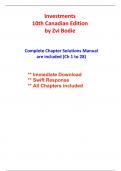Investments
10th Canadian Edition
by Zvi Bodie
Complete Chapter Solutions Manual
are included (Ch 1 to 28)
** Immediate Download
** Swift Response
** All Chapters included
, CHAPTER 1:
THE INVESTMENT ENVIRONMENT
PROBLEM SETS:
1. While it is ultimately true that real assets determine the material well-being of an economy,
financial innovation in the form of bundling and unbundling securities creates opportunities
for investors to form more efficient portfolios. Both institutional and individual investors
can benefit when financial engineering creates new products that allow them to manage
their portfolios of financial assets more efficiently. Bundling and unbundling create
financial products with new properties and sensitivities to various sources of risk that
allows investors to reduce volatility by hedging particular sources of risk more efficiently.
2. Securitization requires access to a large number of potential investors. To attract these
investors, the capital market needs:
1. A safe system of business laws and low probability of confiscatory
taxation/regulation;
2. A well-developed investment banking industry;
3. A well-developed system of brokerage and financial transactions; and
4. A well-developed media, particularly financial reporting.
These characteristics are found in (indeed make for) a well-developed financial market.
3. Securitization leads to disintermediation; that is, securitization provides a means for
market participants to bypass intermediaries. For example, mortgage-backed securities
channel funds to the housing market without requiring that banks or thrift institutions
make loans from their own portfolios. Securitization works well and can benefit many,
but only if the market for these securities is highly liquid. As securitization progresses,
however, and financial intermediaries lose opportunities, they must increase other
revenue-generating activities such as providing short-term liquidity to consumers and
small business and financial services.
4. The existence of well-developed capital markets and the liquid trading of financial assets
make it easy for large firms to raise the capital needed to finance their investments in real
assets. If Suncor Energy, for example, could not issue stocks or bonds to the general
public, it would have a far more difficult time raising capital. Contraction of the supply of
financial assets would make financing more difficult, thereby increasing the cost of
capital. A higher cost of capital makes investments in real assets less profitable/viable
leading to lower real growth.
5. Even if the firm does not need to issue stock in any particular year, the stock market is still
important to the financial manager. The stock price provides important information about
how the market values the firm's investment projects. For example, if the stock price rises
considerably, managers might conclude that the market believes the firm's future prospects
Bodie et al. Investments 10th Canadian Edition Solutions Manual
1-1
, are bright. This might be a useful signal to the firm to proceed with an investment such as an
expansion of the firm's business.
In addition, shares that can be traded in the secondary market are more attractive to initial
investors since they know that they will be able to sell their shares. This in turn makes
investors more willing to buy shares in a primary offering and thus improves the terms on
which firms can raise money in the equity market.
Remember that stock exchanges like those in New York, Toronto, and London are the heart
of capitalism, in which firms can raise capital quickly in primary markets because investors
know there are liquid secondary markets.
6. a. No. The increase in price does not add to the productive capacity of the economy.
b. Yes, the value of the equity held in these assets has increased.
c. Future homeowners as a whole are worse off, since mortgage liabilities have also
increased. In addition, this housing price bubble will eventually burst and society as a
whole (and most likely taxpayers) will suffer the damage.
7. a. The bank loan is a financial liability for Lanni, and a financial asset for the bank. The
cash Lanni receives is a financial asset. The new financial asset created is Lanni's
promissory note to repay the loan.
b. Lanni transfers financial assets (cash) to the software developers. In return, Lanni
receives the completed software package, which is a real asset. No financial assets are
created or destroyed; cash is simply transferred from one party to another.
c. Lanni exchanges the real asset (the software) for a financial asset, which is 1,250 shares
of Microsoft stock. If Microsoft issues new shares in order to pay Lanni, then this would
represent the creation of new financial assets.
d. By selling its shares in Microsoft, Lanni exchanges one financial asset (1,250 shares of
stock) for another ($125,000 in cash). Lanni uses the financial asset of $50,000 in cash to
repay the bank loan and retire its promissory note. The bank must return the promissory
note (financial asset) to Lanni. The loan is now "destroyed" in the transaction, since it is
retired when paid off and no longer exists.
8. a.
Liabilities &
Assets
Shareholders’ Equity
Cash $ 70,000 Bank loan $ 50,000
Computers 30,000 Shareholders’ equity 50,000
Total $100,000 Total $100,000
Ratio of real assets to total assets = $30,000/$100,000 = 0.30
Bodie et al. Investments 10th Canadian Edition Solutions Manual
1-2




